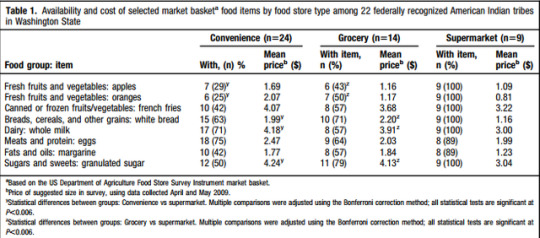Text
Overview
The topic I chose to investigate is access to healthy foods for Native Americans living on reservations, and the resulting health disparities that come from a possible lack of access to healthy foods. I chose this because I have been taught that the “winners write the history books” from my History teacher father, so I believe due diligence should be served in providing a further explanation for the prevalent issues on Native American reservations. As well, my boyfriend of eight years is a registered tribal member of the Chemehuevi Tribe, a small but resilient band of Native Americans who live on the border of Arizona and California at Havasu Lake. His mother lives on the reservation, and from visiting her, I have seen the effects of food insecurity (the main and reoccurring theme of this report) and the health-related issues that appeared on the Chemehuevi reservation. This led me to research “why are things like this” in which I discovered that such issues are not isolated incidences on one reservation but actually commonplace on reservations nationwide. The following research provides an examination of the findings with initiatives that may be implemented in hopes of alleviating these issues.
0 notes
Quote
“Everything on the earth has a purpose, every disease an herb to cure it, and every person a mission. This is the Indian theory of existence.
First Native American female author Mourning Dove (Christal Quintasket) of the Salish people, 1888-1936.
1 note
·
View note
Text
Introduction
Nutritious foods include fruits, vegetables, whole grain and minimally processed foods; in this context, it should be noted to include “culturally appropriate” Native foods. Historically, Native Americans pre-colonization were hunters, gatherers and agriculturalists (Bauer, Widome, Himes, Ph.D., Smyth, Holy Rock, Hannan, MStat & Story 2012:1346) who used from their environment with little to no waste and in accordance with seasons. Through assimilation and the introduction of reservations, Native Americans on reservations developed more sedentary ways of life, with food to match, that in fairness can be paralleled to the greater society at large off reservations. In comparison to other U.S demographics, Native American populations are more likely to have low socioeconomic statuses, to be unemployed and experience higher levels of food insecurity (Chino, Haff & Francis 2009:281). Sedentary lifestyles on reservations in addition to the proximity of food stores on or near reservations and the availability of healthy foods within stores have led to a prevalence of health issues such as diabetes, high blood pressure, and obesity. A quote from the research states that “despite 60 years of participation in the USDA’s food assistance programs, American Indians suffer high rates of debilitating chronic diseases associated with persistently poor diets including obesity and diabetes.” (Chino et al 2009:281). This drastic change can also be attested to industrialization and globalization which allowed for the dispersal of foods, and cheap labor, throughout the world. (Bauer et al 2012:1346)
Reservation- “An area of land set apart by the government for occupation by American Indians.” Reservations are located typically in rural areas. https://en.oxforddictionaries.com/definition/indian_reservation
Assimilation- “The absorption and integration of people, ideas, or culture into a wider society or culture.” https://en.oxforddictionaries.com/definition/assimilation
Industrialization- “The development of industries in a country or region on a wide scale.”
Globalization- “The process by which businesses or other organizations develop international influence or start operating on an international scale.” https://en.oxforddictionaries.com/definition/globalization
Food insecurity- “The state of either having limited or uncertain access to food that is nutritionally adequate, culturally acceptable, and safe or having an uncertain ability to acquire acceptable foods in socially acceptable ways.” (Bauer et al 2012:1346)
0 notes
Photo
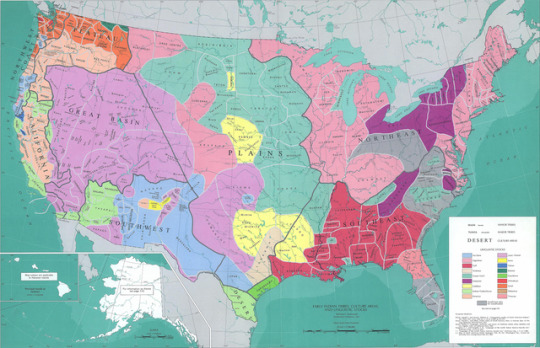
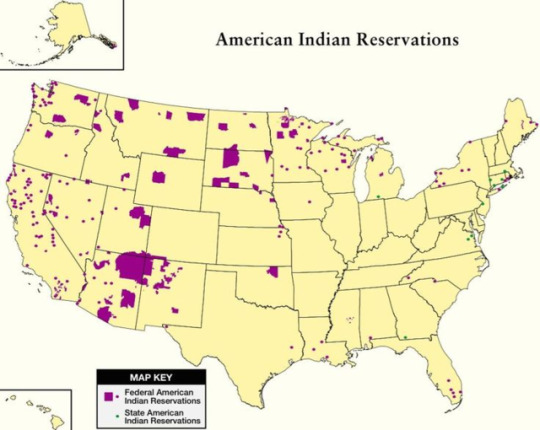
“Historical Map of the United States - Early Indian Tribes, Culture Areas, and Linguistic Stocks.” William C. Sturtevant, Smithsonian Institution, 1967.
https://www.census.gov/dmd/www/pdf/512indre.pdf (2010)
2 notes
·
View notes
Text
Introduction continued: Food is the Center of Culture
“American Indian populations used the land they lived on for hunting and growing food, and therefore consumed a plant-based diet supplemented with fish or low-fat meat.” (Bauer et al 2012:1346)
In regards to the specifics of the Native American diet, historically the major staples have been corn, beans, and squash, referred to as “three sisters” as they were always grown together. Corn was the predominant food source grown by Native Americans, and while potatoes, tomatoes, and peppers were also grown, the three sisters were the “backbone of North American Indian agriculture and provided the primary dietary staples of many tribes.” (Park, Hongu & Daily III 2016:172). It should be noted that early food sources are difficult to identify with conviction, however Park et. al state that we can be certain that nearly all available plants and animals were used as sustenance for Native Americans (2016:172).
1 note
·
View note
Photo
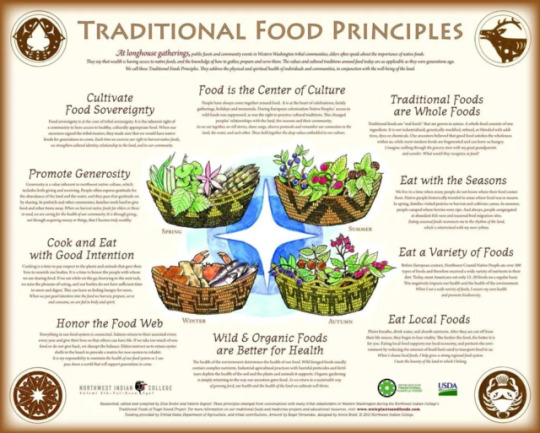
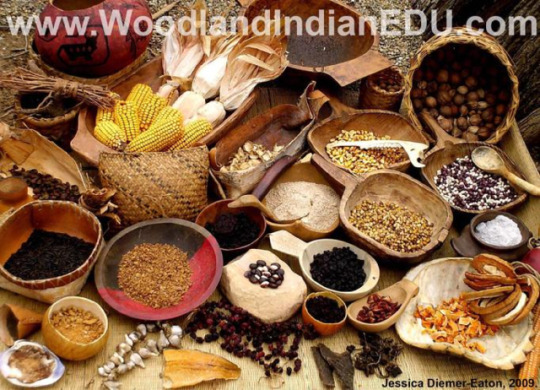
“Food is the Center of Culture” researched by Elise Krohn and Valerie Segrest, and designed by Annie Brule. Copyright 2013 Northwest Indian College, http://nwic.edu.
Native American staples: nuts, grains, and corn. http://woodlandindianedu.com/
4 notes
·
View notes
Text
Today: The Food Environments of Native American Reservations
I sought to address the following questions:
- If not the traditional foods, what is the diet of Native Americans on reservations?
- Are nutritious foods accessible for residents on reservations, and are they affordable?
- What are the resulting health effects of food insecurity/lack of nutritional foods for Native Americans on reservations?
0 notes
Text
The Reservation Diet: The Conundrum of Healthy Eating and Food Insecurity
- If not the traditional foods, what is the diet of Native Americans on reservations?
Bauer, Katherine W, PhD., M.S., Widome, Rachel, PhD., M.H.S., Himes, John H, PhD., M.P.H., Mary Smyth M.S., Bonnie H. Rock B.A., Peter J. Hannan M.Stat and Story, Mary, PhD., R.D. 2012. "High Food Insecurity and its Correlates among Families Living on a Rural American Indian Reservation." American Journal of Public Health 102(7):1346-1352
“American Indians living on reservations often rely on food–commodity and nutrition assistance programs and frequently purchase food from fast-food outlets and small grocery or convenience stores, which typically have a limited availability of high-quality produce and low-fat foods.”(Bauer et al 2012:1346).The studies pertaining to food insecurity on Native American reservations conclusively confirmed that the phenomenon was widespread and affected reservation residents across the United States. The type of foods available through government-issued commodities and in food stores, the number of food stores on or near reservations, the distance of residents to food stores and the availability of healthy foods within stores were evaluated throughout the research and found to significantly impact the health and well-being of residents. As a result of food insecurity, health disparities were prevalent on all examined reservations.
The study “High Food Insecurity and Its Correlates Among Families Living on a Rural American Indian Reservation” seeks to explain the presence and results of food insecurity among Native American families with young children. The authors define food insecurity as “the state of either having limited or uncertain access to food that is nutritionally adequate, culturally acceptable and safe having an uncertain ability to acquire acceptable foods in a socially acceptable ways” (Bauer et al 2012:1346). Bauer et al pose the theory of the harmful effects of food insecurity on a child’s physical, social and emotional health (2012:1346). The authors continue with the stance that children who lack food security, in comparison to food-secure children, are more likely exposed to illnesses, both chronic and acute, and suffer from psychosocial problems and psychiatric distress. According to the authors, the children affected by food insecurity are also less likely to have high academic performance. As well, the authors relay that the roots of food insecurity lie in economic factors: insufficient income, high amount of debt, and a high cost of living/living expenses. Lastly, they convey that it is the lack of physical access to foods that help sustain in a community that raises the chances of a family’s food insecurity status.
14 schools with a Native American population were involved, and 97% of children’s parents participated. 432 parents of the 454 eligible children completed the administered survey and included in the study. 99.3% of children were of Native American descent and almost all of them were from the Oglala Sioux tribe (the people are referred to as Lakota). The data supplemented for the study was reaped from a survey distributed to parents and caregivers of children in kindergarten (or kindergarten age children) enrolled in a previous study called Bright Start. The purpose of Bright Start is the monitoring of weight gain among children of the Lakota tribe living on or near the Pine Ridge Reservation in South Dakota. The questionnaire completed concerned questions regarding the child’s dietary intake, the food environment in the home and food security itself. Food security was looked at using a 6-item scale and associations of food insecurity with sociodemographic attributes: both parents and children’s weight, children’s dietary habits and the food environment in the home.
Researchers found that nearly 40% of families stated they experience food insecurity. Children from houses with food insecurity were likely to eat nutritionally deficient types of foods, many of which that were purchased at convenience stores.
0 notes
Text
Food Availability and Affordability
- If not the traditional foods, what is the diet of Native Americans on reservations?
While the health benefits of a nutritious diet are established, the maintenance of such can prove to be difficult depending on the access to nutritious foods, the consistency of available foods and the cost. These factors directly influence the behaviors of individuals partaking in the consumption within the environment, especially those who are low-income, members of minority groups, and those living in rural settings (O’Connell, Buchwald & Duncan 2011:1375).“Furthermore, energy-dense foods are less expensive on a per-calorie basis than low-calorie, nutritious foods. This suggests that individuals with limited financial resources may choose to purchase cheaper energy-dense foods to maximize their spending power.” (O’Connell et al 2011:1376). Packaged, canned, processed and nutrient dense foods are typical on reservations due to overwhelming food insecurity, affordability, and availability. “In regards to available food products, eggs, white bread, and whole milk were the most steadily accessible items in all stores. The most common item in convenience stores was eggs; in grocery stores, granulated sugar was the most prevalent. The availability of items such as apples and oranges was consistently found throughout all nine supermarkets, higher than in both convenience and grocery stores. Convenience stores were prominent over both grocery stores and supermarkets on the reservations which carried significantly less nutritionally beneficial foods.” (O’Connell et al 2011:1377). Researchers assessed food types, abundance and scarcity of foods and distance from food stores on 22 Native American reservations in Washington state according to the USDA Food Store Survey Instrument used in collaboration with the “national standard for a minimally nutritious diet at minimal cost” (O’Connell et al 2011:1376) or the Thrifty Food Plan. Compared to on-reservation supermarkets, off-reservation supermarkets had slightly more items from each of the food groups, however, the difference was not significant. Off-reservation supermarkets had about 94%, while on-reservation supermarkets had approximately 86% of all market basket items. No supermarkets had all items in the market basket and items were missing at random. “The average cost of the Thrifty Food Plan market basket for the nearest off-reservation supermarkets was $144.52. In contrast, the USDA reference cost of the same Thrifty Food Plan market basket was $135.10.” (O’Connell et al 2011:1378). A result of O’Connell et al’s research found in comparison to Thrifty Food Plan market basket, tribal members of the communities studied who shop at their nearest supermarket would pay “$36 more per month than a consumer purchasing the same market basket at reference cost.” That is, items were higher in price in the nearest supermarkets to reservations. The average cost was based on 19 supermarkets (in Washington) as one supermarket was the main source of food for three different tribes (O’Connell et al 2011:1378).
0 notes
Text
Government Commodities
Government commodities include canned meats, soups, pasta, cereal, rice, cheese (“government cheese”), peanut butter and juices. For cooking and baking, corn syrup, flour, dry, evaporated milk and vegetable oil. The program began as an effort to create food security on Native American reservations as malnutrition was of great concern as recently as 1967 (Chino et al 2009:282). However, the high fat and calorie, low in fiber foods were of stark difference to traditional Native diet which led not to malnutrition but obesity as a concern on reservations within only a generation (Chino et al 2009:282).
“Comod-Bod”
“The use of the term “Comod-Bod” in tribal communities captured the essence of the [diet and lifestyle] changes that occurred. The addition of commodities to American Indian diets was part of a group of changes that together have influenced current health problems.” (Chino et al 2009:282).
0 notes
Text
Frybread, a traditional Native food?
Frybread- “a flatbread made by North American Indians of the SW U.S., that is cooked by frying in deep fat until light brown and puffed on both sides.” https://www.collinsdictionary.com/us/dictionary/english/fry-bread
Frybread is a typical food consumed by Native Americans living in the Southwest, all the ingredients to make it typically included in a monthly government commodity package. While frybread does not appear to be apart of a traditional hunter-gatherer native diet, it has a history embedded within Southwest Native American culture. It originated over 144 years ago by the Navajo people as a result of the U.S mandated “Long Walk” in which the government forced the Navajos to walk 300-miles to relocate to New Mexico onto land where their traditional staples of vegetables and beans [three sisters] could not be easily grown. Due to the lack of agricultural growth, the government gave them “canned goods as well as white flour, processed sugar and lard [government commodities]—the makings of frybread.” (Miller 2008).
2 notes
·
View notes
Photo


https://i.pinimg.com/736x/fa/72/b3/fa72b3c8bd264232793dee581e13db0--native-american-bread-recipes.jpg
https://i.pinimg.com/736x/a9/ff/0f/a9ff0fb12d80e70832fd3d800211d51--frybread-native-humor.jpg
1 note
·
View note
Text
Indian/Navajo Taco
“Indian”/Navajo taco- a Frybread based taco with “traditional” taco filling- ground cow meat, sour dairy cream, dairy cheese, lettuce and tomato (if available). This is a dish expected to be served at powwows, get-togethers, and special events as well as a typical accompaniment in Southwest reservation households.
0 notes
Photo

https://sd.keepcalm-o-matic.co.uk/keep-calm-eat-indian-tacos-2.png
2 notes
·
View notes
Quote
Frybread is emblematic of the long trails from home and freedom to confinement and rations. It’s the connecting dot between healthy children and obesity, hypertension, diabetes, dialysis, blindness, amputations, and slow death. If frybread were a movie, it would be hard-core porn. No redeeming qualities. Zero nutrition.
Suzan Shown Harjo, Native American writer and activist
http://www.smithsonianmag.com/arts-culture/frybread-79191/#8RqeWGbKMGQSsXrz.9
2 notes
·
View notes
Text
Access to and Distance from Food Stores
In a study done to examine the food environments of Native Americans on California reservations, Chodur, Shen, Kodish, Oddo, Antiporta, Jock, Jones-Smith (2016) the results showed that distance to both healthy and unhealthy food sources was significantly further for reservation areas compared to non reservation areas, “a reflection of the actual food environment experienced by American Indians living in tribal areas.” (11)
- Are nutritious foods accessible for residents on reservations, and are they affordable?
Chodur et al includes responses from reservation residents on the distance from food stores, a resulting consensus which confirms the statement in O’Connell et al’s research which stated this if an individual lacks resources or has difficulty traveling to food sources, they will likely buy “relatively less healthy and more costly items in convenience stores that are easily accessible to their home” (O’Connell et al: 2011:1379). Additionally, food purchased that is less expensive and lasted longer were motivating factors for the purchases themselves.
1 note
·
View note
